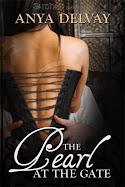
So, you want to dress up Victorian. Do you crave the look of Steampunk? Did you know that dressing up Victorian means you're taking your own LIFE in your hands?
Dressing up Victorian is a time commitment, and a hazard unto itself, but darn it's fun! During the mid-1800's fashion changed dramatically within a fifty year time period.
In 1860, women were tightly corseted from their youth, trying to achieving the perfect lift to their bosom and that desirable 20 ¼-inch waist. Because of a tightly corseted silhouette women's ribcages were severely narrowed, their internal organs compressed. After years of being corseted women's muscles would atrophy, and without the use of the corset they had a hard time standing or even walking.

Around 1880, again women were corseted at a young age, the bosom uplifted but the middle was thicker and there was definition on the bum. This was of course when bustles made the scene. Bustles were not used to accentuate a huge butt, but as status. The more fabric you could drape back there, the higher your status.
In the 1900's the "mono-bosom" (or uni-boob as I like to call it) look was in. Women would still wear the corset, but they would stuff their chests to get a rounded bosom. The look was an "S" curve look.
I think the most interesting time period of dressing as a Victorian lady was 1860. Ahhh, 1860, you're a lady and you've just woken up from a lovely slumber. QUICK be decent; put on your wrapper aka your bathrobe. Whew, now that you've finished your ablutions it's time to get dressed.
Peeling off the wrapper, we see you're wearing the most intimate of your clothing. Your chemise. The chemise was comprised of intricate tucks and a scoop neck front, which would loosen and allow you to wear a more off-the-shoulder neckline.
First, let's get on your drawers, your crotchless drawers. Kinky. Not really, in the 1860's it was a sin for women to wear breeches so drawers, pantaloons or pantalets were not allowed to have a crotch because it was too close to a man's breeches. Of course it also helped when one needed to squat over yonder chamber pot.
Next, after our drawers are slipped on it's time to get on those socks and shoes. What? You say I missed a step. Nope, you have to put on your socks and shoes now because once you're in your corset and stays you aren't going to be bending over. Socks were brightly coloured and garish. In 1859, the knitting machine had been invented and women benefited from brightly and tightly knitted socks, which they would garter with suspenders, slung around their hips. Some socks even had elastic woven into them to garter them. After the socks came the new thing, left and right buckled shoes. Before 1860, the woman wore straight shoes, slipper like, which were interchangeable.
After we have our socks and shoes on next is the corset, comprised of metal or whalebone stays. A good tightening of a corset could shed about three to four inches off your waist.
After the corset came the crinoline, hoop or cage skirt. Before 1856, which brought the advent of the crinoline, women would have to wear six or seven flannel horsehair petticoats to achieve the desired fullness. Can anyone say heat stroke?
Over the crinoline came the petticoat, with an elaborate flounce that helped with fullness.
The skirt came over the petticoat.
The silhouette so far is a wide one. So much so, that approximately 40,000 women died in England alone from their skirts catching on fire. YIKES! I told you it was hazardous to your health now didn't I?
Oh yes, next came the bodice. The chemise could be adjusted depending on how much shoulder you wanted to show. Sleeves were not really a permanent part of the dress, so under-sleeves were worn. A broach was fastened to the collar.
After this, a snood (knitted hairnet) was attached to keep the hair up. Over this went the bonnet and next the gloves.
There, you're all dressed and ready to enjoy a day on the town.











